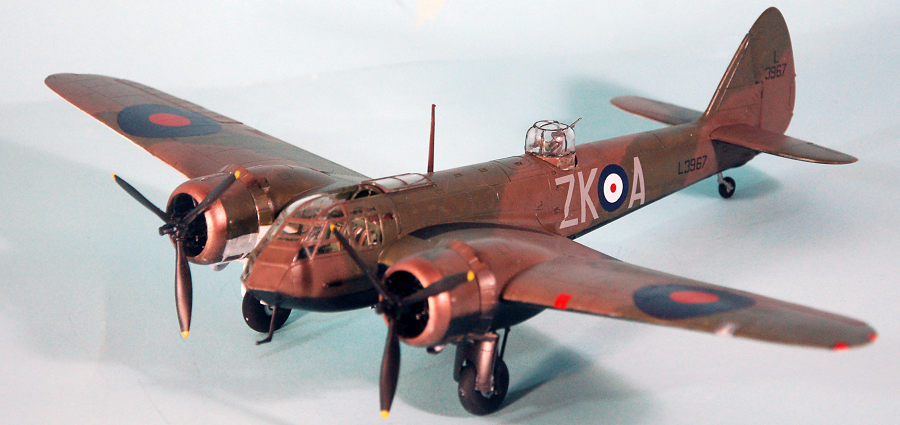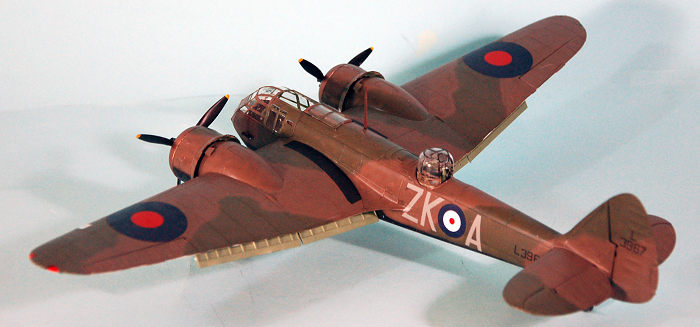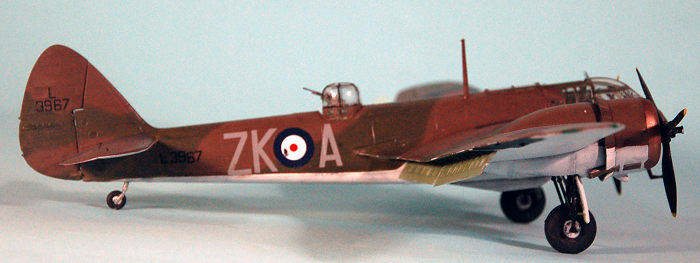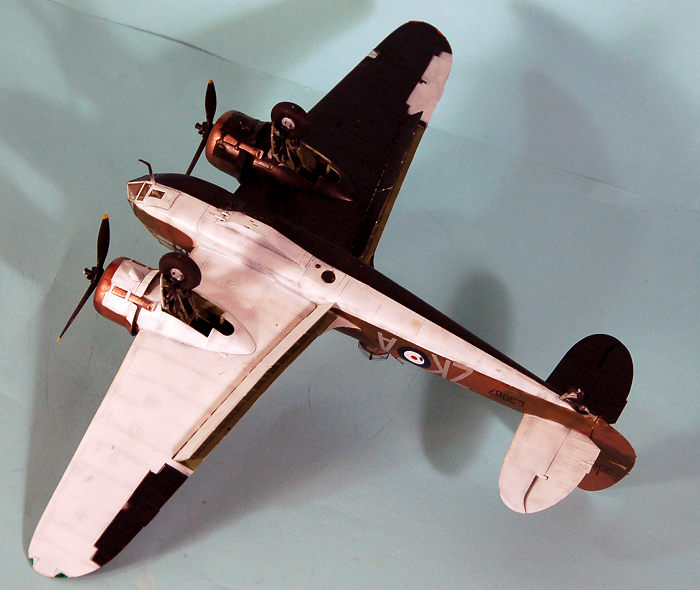
| KIT #: | A09186 |
| PRICE: | $50 or so |
| DECALS: | Two options |
| REVIEWER: | Tom Cleaver |
| NOTES: | 2018 tooling |

| HISTORY |
Such was the pace of aircraft development in the latter half of the 1930s that the Bristol Blenheim, which was the most modern aircraft in Britain when the Type 142 prototype first flew on April 12, 1935, was close to obsolete when called to war a mere four and a half years later.
The Blenheim was the result of a decision by Daily Mail owner Lord
Rothermere, who had grown increasingly concerned that the British aviation
industry was falling behind international standards, to issue a challenge in
1934 for the development of a fast twin-engine aircraft which he could use as a
personal transport. As it
 happened, Bristol’s chief designer, Frank Barnwell,
had commenced development of a twin-engine passenger aircraft the previous year
with a designed cruising speed of 250 mph, which was faster than every RAF
fighter at the time. The result was the Type 142 “Britain First,” a 6-passenger
aircraft with a maximum speed of 307 mph. The Air Ministry was immediately
interested after Lord Rothermere donated the Type 142 to the RAF. Barnwell had
already foreseen the possibility of modifying the plane as a high speed light
bomber, and the RAF ordered 150 before the bomber prototype had flown.
happened, Bristol’s chief designer, Frank Barnwell,
had commenced development of a twin-engine passenger aircraft the previous year
with a designed cruising speed of 250 mph, which was faster than every RAF
fighter at the time. The result was the Type 142 “Britain First,” a 6-passenger
aircraft with a maximum speed of 307 mph. The Air Ministry was immediately
interested after Lord Rothermere donated the Type 142 to the RAF. Barnwell had
already foreseen the possibility of modifying the plane as a high speed light
bomber, and the RAF ordered 150 before the bomber prototype had flown.
Named Blenheim in memory of the Duke of Marlborough’s defeat of the French at Blenheim, Bavaria in 1704, the Blenheim I had a crew of three: pilot, bomb aimer/navigator, and gunner, and could carry a 1,000 pound bombload at 282 mph. Handling was “fighter-like” and maneuverability was excellent. The first Blenheim Is arrived in service in March 1937.
In 1938, in answer to the need for a long range fighter capable of operating at night, the Blenheim Mk.IF appeared, modified with a package of four .303 machine guns bolted over the bomb bay doors below the cockpit. 200 Ml.I bombers were modified to this fighter configuration in 1938. With the extra weight of guns and ammunition, top speed dropped to 260 mph.
 The Blenheim IF was first issued to 600 RAuxAF Squadron at Hendon in
September 1938. By the outbreak of war in 1939, seven squadrons were operational
on the type. The Mk IF proved to be slower and less nimble than expected; by
June 1940, daylight losses were such that it was decided the Mk IF would be
assigned strictly to night fighter duties where 23 Squadron which had operated
as a night fighter squadron since the outbreak of war, had shown success.
The Blenheim IF was first issued to 600 RAuxAF Squadron at Hendon in
September 1938. By the outbreak of war in 1939, seven squadrons were operational
on the type. The Mk IF proved to be slower and less nimble than expected; by
June 1940, daylight losses were such that it was decided the Mk IF would be
assigned strictly to night fighter duties where 23 Squadron which had operated
as a night fighter squadron since the outbreak of war, had shown success.
Blenheims shot down five German bombers in the night-bombing raid on London on 18 June 1940. That months, 600 Squadron, by then based at RAF Manston, had some of its aircraft equipped with AI Mk III radar. A radar-equipped Blenheim from the Fighter Interception Unit (FIU) at RAF Ford achieved the first success on the night of 2–3 July 1940 when it shot down a Dornier Do 17. By the winter of 1940, when the Germans began the Blitz, the Blenheim proved itself invaluable as a night fighter. Gradually, with the introduction of the Bristol Beaufighter in 1940–1941, the Blenheim was supplanted by its faster, better-armed descendant.
| THE KIT |
The first 1/48 kit of the Blenheim I was released by Classic Airframes around 2000. It is a limited-run kit, with resin wheel wells and cockpit that have to be cut off of massive casting blocks. While it makes up into an attractive model, it is definitely a battle to get there.
 This kit by Airfix is the first mainstream injection-molded kit of the
Blenheim in 1/48, and follows the release in 2016 of the Blenheim IF and IVF in
1/72 scale. The kit is well-designed and very nicely-detailed throughout, with
the option of having the entry hatch open or closed. The dropped flaps will
create problems for a modeler who wants to raise them and are best left down;
all other control surfaces are also separate. Decals are provided for the
restored Blenheim IF in 23 Squadron markings and for a radar-equipped night
fighter of an OTU.
This kit by Airfix is the first mainstream injection-molded kit of the
Blenheim in 1/48, and follows the release in 2016 of the Blenheim IF and IVF in
1/72 scale. The kit is well-designed and very nicely-detailed throughout, with
the option of having the entry hatch open or closed. The dropped flaps will
create problems for a modeler who wants to raise them and are best left down;
all other control surfaces are also separate. Decals are provided for the
restored Blenheim IF in 23 Squadron markings and for a radar-equipped night
fighter of an OTU.
All the parts are there to create a Blenheim bomber if one is so inclined. It is obvious the kit will be released as a bomber in the future, and very likely that a 1/48 Mark IV is on the list of future releases.
| CONSTRUCTION |
Like all the other very nice releases from “New Airfix,” a modeler will not go wrong if they commit the revolutionary act of following the very clear and logically laid-out instructions. If you do this and are careful in fitting parts, you will not need any filler.
There is a very good article in the November 2018 issue of Airfix Model World magazine on constructing the model, which I referred to in my project.
I began by painting as many of the parts as possible while they were still on the sprues.
 Construction begins with the bomb-bay, where the spars the wings will be
mounted on are attached. The cockpit is best assembled by doing the pilot’s
section separately, and then attaching it to the bomb bay/spar assembly after it
is complete. I made seat belts from lead foil. Once the fuselage was together, I
attached the one-piece bomb bay doors to close up the bomb bay.
Construction begins with the bomb-bay, where the spars the wings will be
mounted on are attached. The cockpit is best assembled by doing the pilot’s
section separately, and then attaching it to the bomb bay/spar assembly after it
is complete. I made seat belts from lead foil. Once the fuselage was together, I
attached the one-piece bomb bay doors to close up the bomb bay.
The landing gear must be assembled when you assemble the wing sub-assemblies. The gear is a model in itself and very complete. The engine and cowling as very complete; the multiple-piece cowling is the one “fiddly” part of the whole assembly process. Follow the instructions: attach the completed engine to the exhaust collector ring, then attach the cowling pieces and be careful to get a close fit. You have the option of open or closed cooling flaps.
The wings slip onto the spars, and if you are careful in assembly there will be no need of filler. I rubber-banded the wings to press them against the fuselage and get a tight fit while the glue set.
I attached the horizontal stabilizer and elevators with the elevators in a down position. The ailerons and the rudder were attached in the neutral position.
The three-piece canopy requires care in assembly, but it goes together in a nice tight fit. I used Micro Krystal-Klear white glue to attach the two halves along the centerline and to attach the upper forward piece. I decided to leave off the sliding hatch, to place it in the open position during final assembly. Masking the canopy for painting was the longest process of the whole project. If Eduard releases a pre-cut mask, I will use it for any other Blenheim I do.
| COLORS & MARKINGS |
 I decided to do the model as a Blenheim IF from 25 Squadron, the first
regular RAF squadron to equip with the type in 1938. This allowed me to paint
the model with the black/white undersurface identity scheme. After pre-shading
the model and painting the left wing black, I masked that and did the right side
in white. The upper surface camouflage of Dark Earth/Dark Green was done
freehand, using Tamiya paints.
I decided to do the model as a Blenheim IF from 25 Squadron, the first
regular RAF squadron to equip with the type in 1938. This allowed me to paint
the model with the black/white undersurface identity scheme. After pre-shading
the model and painting the left wing black, I masked that and did the right side
in white. The upper surface camouflage of Dark Earth/Dark Green was done
freehand, using Tamiya paints.
The squadron codes and serial numbers came from the decal dungeon, and the kit decals were used for the rest of the markings. There are several aftermarket sheets for this kit from Xtradecals and SBS that I know of.
I gave the model an overall coat of clear flat finish, then unmasked the canopy. I attached the wheels to the undercarriage, and the props to the engines.
| CONCLUSIONS |
This is another winner from Airfix. “Blenheim boffins” will be happy to know that this kit has the correctly-shaped slightly more “pointed” engine nacelles, rather than the “Bolingbroke” nacelles of the 1/72 kit. Airfix does listen to comments. The kit is designed for ease of assembly, and any modeler with experience of a few kits is assured of a winner if the instructions are followed. Highly recommended for RAF fans.
3 January 2019
Copyright ModelingMadness.com
Review kit courtesy of my wallet. If you would like your product reviewed fairly and fairly quickly, please
contact
the editor
or see other details in the
Note to
Contributors.
Back to the Main Page
Back to the Review
Index Page
Back to the Previews Index Page